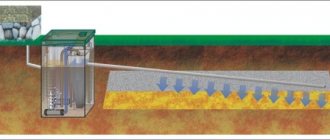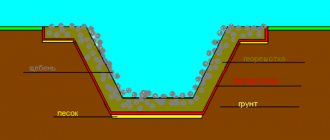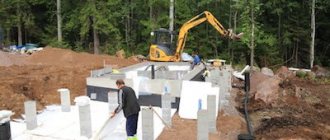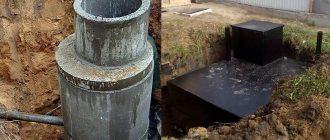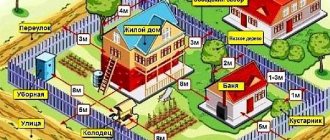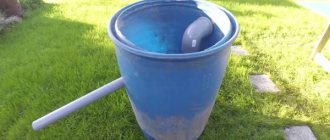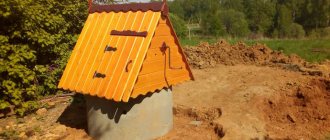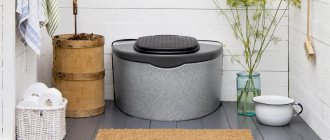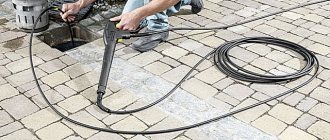Definition and regulatory framework
Storm drainage, also known as rain drainage, also known as storm sewer, is a multicomponent engineering system designed to collect and drain precipitation and melt water. But if in most cases it is aimed specifically at getting rid of excess moisture, then in some situations it can also be used to obtain the missing one. When there are problems with water supply in the area, rainwater will be an excellent help. How much can actually be collected from a roof, depending on the area and level of precipitation, can be calculated exactly if desired, but there is also the result of “full-scale tests”.
GerasimForumHouse Member
My statistical patch: a roof of 100 m², a drain in four corners, one corner led into a four-cube font. A full font (from 25 m² of roof) is filled in a month. Not Moscow, but the north of the Moscow region.
And even if this water is technical and “along the way” it will pick up dust and debris, it is quite possible to use it for irrigation and other needs that do not require crystal transparency.
In a more familiar functionality, the storm drainage system of a house, together with the blind area, protects the foundation of the house and other buildings and prevents the formation of stagnant puddles. This is on sandy soils with a low groundwater level and a couple of hours after the rain there is nothing left anywhere. And on clay, and even with high water flow and in the summer, or even in the off-season, without the construction of a storm sewer there will be not a yard, but a swamp.
Although almost all existing standards are advisory in nature in relation to private sector objects, this is not a reason not to use them. Why reinvent another kind of wheel when everything has already been thought out and calculated, all that remains is to apply it. When calculating storm drainage for your country house, you need to focus on the current SP 32.13330.2018 Sewerage. External networks and structures. SNiP 2.04.03-85. At the moment, this is the latest updated edition, developed in another century and another state of rules. It applies to both those under construction and those already in operation and those being reconstructed.
Features of drainage systems
Drainage systems are otherwise called deep, since they are laid at a certain depth along the perimeter of the house above the foundation and/or on the site. The dehumidification system includes the following main elements.
- Drainage pipes for collecting and discharging water are polymer, with perforation; They produce both double-layer, with a smooth inner and corrugated outer wall, and single-layer, diameter is 110 mm and 160 mm (calculated value).
- Drainage wells are polymer, diameter 300-500 mm.
Maria SukharevaSpecialist at Uponor
Drainage wells are maintenance points for inlet and outlet sections of the pipeline and provide access to drainage pipes for cleaning, which increases the maintainability of the system. In foundation systems, drainage wells are installed at every corner of the house, in plots - at every second bend.
- Collector wells are one or more final elements of a system designed to collect drained water. Depending on the water absorption capacity of the soil, collector wells can be either sealed, designed for periodic pumping, or absorption (filtering).
Types of storm systems
As on an industrial scale, two types of storm sewer systems are common in the private sphere, differing in their operating principles: point and linear.
Point storm drainage is local - it consists of several storm inlets installed under gutters and drainage systems of open or closed type. This is the most common type of storm drainage system, implemented by the majority of homeowners, since there is little good in flooding the site with every rainstorm.
Linear storm drainage is more complex - it is designed to collect and drain wastewater from the site and is somewhat reminiscent of radial drainage. The difference is that trays or open channels are installed at ground level, and drainage pipes are laid at depth. But the tasks of the systems are similar - to quickly and effectively drain water from the site and prevent stagnation and wetting of the root system of fruit and ornamental crops. Unlike a point one, a linear type storm sewer system is always individual, and its layout is tied to the topography of the site.
Scheme of an autonomous sewer system with a sewerage absorption field
Filtration of sewage effluent from a septic tank into natural soil, through an absorption field, drainage tunnel or filter well, is possible in an area where:
- The groundwater level is low - at least 1.5 m. from the surface of the area. The area should not be periodically flooded.
- The filtering capacity of the soil should not be too small. Almost all soils, except clay, are suitable for ground drainage.
- The dimensions of the site must allow the placement of drainage pipes, a tunnel or a filter well at a distance of at least: from the well and well, including on the neighboring site - 30 m. upstream of groundwater or 15m. against the current or 19m. perpendicular to the flow of groundwater; from the house - 3m; from the border of the site - 2m; from trees and large bushes - 3m.
In an area with a high groundwater level, drainage pipes are laid in embankments so that the distance to the water level is at least 1.5 meters.
If the groundwater level is high, the absorption field can be placed in an embankment.
The height of the embankment is made to ensure a distance from the drains to the groundwater level of at least 1.5 m.
The thickness of the soil layer in the embankment above the drainage pipes must be at least 0.4 meters. The embankment is protected from freezing. Plants with a shallow root system are planted on the embankment.
An electric pump must be installed in the well of the pumping station to supply wastewater to the drainage pipes on the embankment.
The cost of a drainage system in an embankment increases markedly. In this case, it may be more profitable for wastewater treatment
install a factory-made septic tank with active biological treatment.
Storm drain equipment
Point storm drainage is equipped with a standard set of elements.
- Storm water inlets are mostly plastic, less often concrete containers, installed directly under the drainpipe.
- Branches are specialized two-layer pipes or pipes for external sewerage, laid underground, through which wastewater is discharged outside the site or to a collection point. Bends can also be of an open type, in the form of polymer or concrete trays with gratings, homemade ones made from asbestos-cement or polymer pipes dissolved in half, or simply ditches dug in the ground.
- Water intakes - if we are talking about country cottage settlements, rural settlements or gardening partnerships, they usually have a common rainwater drainage system in the form of drainage ditches along the boundaries of the plots. In this case, the outlets discharge water outside the yard. Less often, a drainage ditch is located directly on the site, in a lowland; it can also be a functional and decorative dry stream or pond. In the absence of this, storm sewer effluent is directed to a receiving absorption (drainage) well, where it settles, filters through a layer of crushed stone and is gradually absorbed into the ground. Another option is storage storm wells, which are pumped out as accumulation occurs using special drainage pumps.
Linear storm drainage is usually performed not instead of, but together with point drainage, in order to increase the efficiency of drainage of the area. In this case, open ready-made or homemade trays are added to the rainwater inlets. They are installed along blind areas, garden paths, in the parking area and in places where water accumulates around the site.
When are drainage mats installed?
In essence, this is a new, but quite effective technology. Geocomposite mats, which consist of a drainage layer located between non-woven filters, have become widespread. This layer consists of rigid polyamide fibers, thermally bonded at the intersection points. This creates a three-dimensional open structure.
Wall drains
In this case, a structure is constructed in which external waterproofing is done. A trench is dug along the entire foundation, and its depth must be no less than the depth of the foundation.
The foundation wall needs to be waterproofed, and the trench itself is filled with drainage materials. The mats described above can be used with a non-woven geotextile filter and a layer of PVC waterproofing.
If necessary, pipes are laid in the trenches. draining rainwater collected from the roof. In this case, the use of plastic pipes without perforation is provided. Through their use, water from the trays is drained into a water intake well. Rainwater should not be drained into the drainage system, since if the structure overflows, it can rise into the foundation of the structure.
Vertical type drains
Such a structure will have the appearance of a well using pumping and power equipment, which will ensure forced pumping of the wells.
This drainage is most often necessary in agriculture, as well as for drying the land during road construction. To construct the structure, wells and trays are used, which are placed on the water-resistant layer. As a rule, structures are equipped with deep-well pumps. Experts consider vertical drainage to be the most effective. It should also be noted that it is economical if the area has heavy, poorly permeable soil.
Recommended reading: What is an autonomous sewer system?
Vertical drains can be located at different depths, and everything will depend on the location of the aquifer. This depth can be 20-30 or 100-150 meters. In the upper part of the structure, solid water intake pipes are used, but in the lower area they can be with slot-like or regular holes.
As a rule, such wells can operate in different modes, which will depend on the seasons of nature. An important feature of the sewer system is regular auditing. It is carried out to detect faults, which include the presence of sinkholes at the wellhead. In addition, the system requires timely cleaning of the sand and gravel filter, which can periodically become silted.
If a vertical drainage device is provided, it is recommended to pay special attention to the correct operation of the pumped water from the well. If the degree of mineralization of the pumped water is satisfactory, then it can be used for washing the soil and irrigating plants.
What pipes to use for stormwater drainage
For large volumes of wastewater (large roof area, rainy region), the use of only open channels is ineffective, except as additional water collectors. Therefore, rainwater drainage outlets are laid underground from each storm inlet, using polymer pipes in pedestrian load areas and metal pipes (steel, cast iron) if it is necessary to lay a highway through the entrance area. Polymer pipes are used in two types:
- Corrugated two-layer - the outer layer is made of low-density polyethylene, and the inner layer is made of high-density polyethylene. We are talking specifically about specialized pipes with a high class of rigidity, intended for the installation of storm sewers, and not about installation pipes in which electrical cables are laid.
- Red sewer - they are designed to drain gray wastewater from the house to local treatment facilities or to the collector of a centralized network. But in most cases, storm sewers are equipped with these pipes.
The volume of storm drains is a calculated value, depending both on the roof area of the building and on the amount of precipitation falling in the region, but in most cases, a pipe with a diameter of 110 mm is sufficient for storm drainage of even a large private house. In terms of cost, both corrugated and smooth PVC will cost approximately the same, but if we consider convenience and final costs, corrugated is preferable. Due to the flexibility of installation, a minimum number of fittings are required, but they also cost money, and repairs are usually required where there is a connection. The ease of laying a flexible pipe is an order of magnitude higher than that of a rigid pipe, and the corrugation holds its shape no worse. The strength class (SN) of both types is sufficient for underground installation even at great depths. Typically, storm drains are not deeply buried, but when it comes to a point system, the outlet is laid mainly under the blind area.
Types of drainage systems for septic tanks
Filter well
In essence, this design resembles a traditional cesspool, which does not have an insulated bottom. It is into this that the contents of the autonomous treatment plant flow (liquid) for subsequent release into the ground.
This drainage option for a septic tank is more suitable for summer cottages where the sewage system is not used daily. And it takes up much less space compared to other methods of drainage.
When installing such drainage for a septic tank, you dig a hole with your own hands. There are several methods for arranging a pit: decorate the walls with brick (masonry), lay several reinforced concrete rings on top of each other, or place a barrel (preferably plastic) without a bottom. The last option is the least expensive.
Let's look at how to make such drainage for a septic tank. This is the easiest way, since this tank will not need to be waterproofed. The depth of the pit should be such that after putting the container in place there would still be about half a meter left to the surface. In order to reduce the consequences of possible “heaving” of the soil, the bottom is covered first with coarse sand, then with gravel (in layers of 20 cm). In addition, this is an additional filter for wastewater treatment.
To increase the rate of water drainage into the soil with such drainage for a septic tank, the side walls (approximately 0.6 - 0.8 m) from the bottom are perforated. To prevent the holes from “silting up,” the outside of the barrel is sprinkled with fine gravel or expanded clay.
It is necessary to provide a removable lid to allow access to the container when emptying it. In addition, a ventilation pipe is installed to remove gaseous products.
- When draining a septic tank with your own hands, you need to choose the right place to install the drain well. There are certain rules, the violation of which entails administrative liability, not to mention possible conflicts with neighbors.
- Before proceeding with installation, it is necessary to calculate the dimensions of the tank being built. They depend not only on the expected volume of wastewater (including one-time discharges), but also on the characteristics of the soil.
- If water is drawn from a well on a site, then this method is unacceptable, since the lower part of the tank must be located deeper than its bottom. And this is difficult to achieve in practice.
- It is necessary to think about not only the arrangement of the waterproofing layer, but also the insulation of the tank, otherwise it will freeze in the winter.
Nuances of design and implementation of storm drainage
Like any engineering system, a storm drain needs to be calculated and designed, and whether it is a hand sketch or visualization in a graphic editor is secondary. The main condition for good conductivity of the system is compliance with the slope when laying both open channels and underground drainage. This indicator is also regulated by the current joint venture and directly depends on the diameter - for the “top” 110 mm, a slope of 2 cm is set for each linear meter of pipe. A fairly large slope is due to rapidity; if the drainage pipe operates in a constant, measured mode, collecting and removing water, then the rain pipe “rarely, but accurately” removes the pressure flow. On relatively short sections, some reduction in slope is not critical; when laying long highways, it is necessary to maintain the recommended value. Otherwise, the operation of the storm sewer during peak load may be disrupted. When calculating and designing a point storm sewer system with underground drainage, it is necessary to provide rotary wells. Otherwise, the system operation may last less than desired.
LadomirModerator FORUMHOUSE
Standards and recommendations believe, and practice confirms, that turning wells should be installed at least at every second turn. A storm drain can also be used as a turn. Failure to comply with this recommendation reduces the capital (service life) and maintainability of the system.
The rotary well can be either ready-made or home-made - from the same red pipe, the main thing is that the diameter is at least 300 mm, and better yet, even larger. But if you start a collective farm, you will have to figure out both the bottom and the lid, whereas ready-made kits can simply be attached to the pipes.
Let's consider a typical situation.
AHDPEY_RUZAFORUMHOUSE Member
Help design and implement storm drainage. I'm building a house. There is no storm drainage system. I'm very worried. This fall I bought rain receivers. Now I want to prepare for spring and start arranging the stormwater system in the spring. But I have no problem with the theory. What is the calculation, what is needed? How to connect receivers to red sewer pipes? Through a tee or in series. I have eight gutters and a slight slope of the site, relative to the picture - from bottom to top.
Instructions.
LadomirModerator FORUMHOUSE
You need eight storm inlets connected by pipes that discharge the wastewater either into an open drainage ditch or to an underground filtration structure (for example, an absorption well). Stormwater inlets have seats for connecting to pipes; usually they are connected in series, but sometimes you have to use a tee. You will also need rotary wells, we connect storm water inlets and wells with pipes and from the last storm water inlet or well we take the wastewater out for disposal. And if it is impossible to bring wastewater to the surface or into a ditch in an open way, an absorption or collection well (wells) may be needed. The slope of the system should be directed towards the slope of the terrain.
When laying pipes for a rainwater system, there is much less “dancing” with tambourines than when installing a drainage system. The depth of installation in each case is selected individually, but on average it is 30-50 cm. For many, the drainage line runs under the lawn and flower beds; this depth is enough to avoid damaging the pipes during planting and processing. Considering that stormwater is still a seasonal system with maximum load in warm seasons, installation above the freezing level is quite logical. But to be on the safe side, some throw a heating cable into the trench.
The trench itself is dug in compliance with the slope; the pros recommend digging not from the catchment to the discharge, but, on the contrary, from the well (ditch, ravine, stream, pond, etc.) upward. The pipeline is laid without preliminary preparation, directly on the ground, the trench is filled with soil, but if the soil is heaving, crushed stone is added. When installing storm water inlets under them, it is advisable to pour a concrete preparation on top of a layer of crushed stone. Some sources recommend concreting on all sides with pouring into formwork, but this is redundant. Storm water inlets are mounted in the same plane with the formwork and will be securely fixed when laying the rough layers and finishing coating even without a “sarcophagus”. When choosing trays, it is worth considering that concrete trays already have a slope, while plastic trays will have to be arranged for it.
What drainage equipment can be used?
- Rotary and water intake wells. The first design option should be installed in places where pipes will be rotated. PVC is used for their manufacture, and the diameter of the well can be 30 cm and the height 1.25-3 meters. As for water intake wells, they should be located at the lowest point of the earth, and it is important to take into account the topography of the area. Such structures are built to remove moisture. Plastic or reinforced concrete rings are used to make the structure.
- Pumps are required to pump out liquid that needs to be raised to the surface from a certain depth for discharge to another location. The drainage pump must only be operated when submerged in water. As a rule, the electrical part of the product is made of waterproof materials. A well made of plastic or concrete should be built in the lowest place, this drainage pump is immersed in it. A discharge pipe must be laid to the drainage point, which must be fixed to the outlet pipe.
Sources:
Drainage sewerage is a system of perforated pipes, called drains, that function as one with the house's sewer system and septic tank.
At the same time, very often drainage sewers are made to remove wastewater from the bathhouse, because it does not contain large fractions and such water, which has passed through a layer of crushed stone and sand, can be passed into the ground without worrying about the state of the environment.
Storm drainage can also be installed. It is necessary to drain rainwater from the ground surface. In this case, trenches will be laid around the house, equipped with receivers of water coming from the drain.
The content of the article:
Drainage sewer
How does a DIY drainage system work?
Having understood what a sewer drainage system is, you should consider the features of its design.
There is nothing complicated here.
It is a perforated pipe laid in a trench on a drainage layer.
The latter can be played by different materials, depending on the characteristics of the soil, the level of groundwater, and the degree of wastewater contamination.
Gravel, sand and geotextiles are usually used to arrange drainage.
Together, they provide additional wastewater treatment and prevent clogging of sewer pipes with silt.
Gravel, sand and geotextiles
Using a similar principle, you can build a site’s drainage system with your own hands in cases where it is necessary to provide protection against excessive increases in groundwater levels and flooding of the site.
Also, such a system will be a good method for organizing storm drainage that drains water from drainpipes and prevents flooding of the building’s foundation. The only difference here is the absence of drains.
Drainage system of the site without drains
In all of the above cases, you should carefully consider the last point - where the water will flow from the drainage pipes or trenches.
If wastewater from a house must be discharged exclusively into a septic tank or filtration well, then groundwater and rainwater can flow not only into a special collection tank, but also, for example, into a pond or any other body of water.
It can be used to create a bath for poultry.
Site drainage system diagrams
How to make a drainage pipe out of a sewer pipe
The drainage pipe for sewerage is a regular perforated pipe.
You can buy it in any store.
But, if you have a PVC sewer pipe for arranging an external sewer system, then you can make a drainage pipe out of it, and do it with your own hands, because sewer and drainage pipes differ only in the presence of holes in their surface.
Drainage pipes for the site
There are two ways to implement this idea. The first is using a circular saw.
In this case, you will need to do the following:
- take the circular saw. The disc must be equipped with carbide nozzles;
- Using this tool, make many cuts in the pipe, distributing them evenly over the entire surface of the product.
Their length should be 10-20 cm. You need to make sure that there are not too many cuts, because then the pipe will lose its strength; Circular saw for cuts in plastic - remove remaining hangnails with a knife;
- important! The width of the holes should be approximately 5 mm. the distance between the cuts cannot be more than 50 cm. It is desirable that they are located a little more tightly.
You can also make a drainage pipe for sewerage using a drill.
The work will look like this:
Holes in a drainage pipe with a drill
- take a drill and make a large number of holes in the pipe;
- it is necessary to take into account that the diameter of the hole should be smaller than the size of the crushed stone fractions used to arrange the drainage. This will prevent the drain pipe from clogging. The optimal hole diameter is 5 mm. The distance between them should be a maximum of 10 cm.
Drainage pipe with holes
We looked at how to make a drainage pipe from a sewer pipe. You can decide which method to choose based on the available tool.
How to make drainage for sewerage
When thinking about how to properly make drainage for a sewer, you should consider step-by-step instructions that can clarify the situation and give an idea of the sequence and features of the work being carried out.
The drainage will be arranged as follows:
Drainage installation instructions
- We dig a trench of the required length and depth. It is recommended to maintain an optimal depth of 1.2 meters. If the groundwater level in the area is not high, you can make a trench 1.5 meters deep. Be sure to take into account the slope - 1-2 cm for each meter of pipe;
- Add a layer of sand to the bottom of the trench and compact it thoroughly, maintaining the slope. For such work, you need to choose sand with a grain size of 1.5-1 mm;
- Instead of sand, you can fill in a layer of gravel. The size of the fractions should be 20-40 mm;
- We cover the trench with geotextile, which is necessary to prevent siltation of the pipe.
Its edges should extend outside the trench; Drainage installation and pipe laying - pour a layer of washed crushed stone onto the geotextile. It is better to use a fraction up to 16 mm. The layer thickness should be approximately 20 cm;
- lay a drainage pipe on top of the crushed stone layer, observing the slope;
- we connect the drainage pipe with a filtration well or sealed container, where the bulk of the wastewater will flow;
- check all connections for leaks;
- if there are no leaks anywhere, fill the pipe with crushed stone on top, which we cover with the free edges of geotextile;
Filling with crushed stone and wrapping with geotextile - fill the geotextile with soil or sand.
To drain clarified water from the septic tank, you can also build a filtration field.
This is a fairly common drainage system.
Here a trench of the required width is dug; its depth will be 1-1.5 meters.
In the same way, the bottom is equipped with a sand cushion, only several drainage pipes are laid on it parallel to each other with a distance of 0.7-1 meters.
This is what the drainage filtration field looks like
Of course, you can do without geotextiles, but it is still recommended to use this material. It prevents silting of the drainage pipe and extends its service life by an average of 4-5 years.
Types of drainage system slope
It is also important to know that the slope of the sewer pipe will depend entirely on its diameter.
The standard diameter is 110 mm, and the slope is 1-2 cm per meter of product.
If the diameter of the drainage pipe for sewerage decreases, then the slope should increase.
There is a regularity here: the larger the diameter of the perforated pipe, the greater its throughput.
Video
For a private house that is not connected to a central sewer system, the issue of installing a septic tank is extremely important. It is he who is responsible for cleaning sewage, preventing it from entering the ground or water bodies, polluting them.
Any mistake when installing a septic tank can have disastrous consequences: contamination of the area, failure of the sewerage system, deterioration of living conditions in the house, etc. To avoid such an “environmental disaster”, you need to take care of the proper installation of the septic tank itself, as well as the filtration field and drainage system, which are also elements of the sewage treatment system.
How to properly make a drainage sewer system?
The drainage system is a system of perforated pipes, also called drains, that work as one unit with the house's sewer system and septic tank. The installation depth of the pipes directly depends on the location of the latter. The sewer pipe should be installed at a depth of 0.45-0.65 m at an angle of 2-3°. The septic tank is installed at a depth of 1.25-2 m, but not deeper. When the tank is located at a greater depth, difficulties arise with the process of post-treatment of wastewater with anaerobic bacteria.
The perforated pipes of the drainage system must have a diameter of 0.11 m. The diameter of the drain holes located along the pipes depends on their location: in the upper part of the pipes the holes are smaller in diameter, and in the lower part they are larger. This is done to ensure that the wastewater is evenly distributed over the area. At the beginning of the system, their number is greater, and the diameter of the holes is smaller, which prevents wastewater from flowing out immediately. The further the holes are located from the distribution well, the larger their diameter; at the end of the pipes, holes are made at the bottom.
To properly arrange drainage, you need to use a few simple rules:
- the length of each of the drainage pipes should not be more than 25 m, starting from the distribution well and to the installation site of the ventilation fungi;
- the distance between adjacent drains must be at least 1.5 m;
- installation of drainage pipes is carried out at a depth of 1.5 m;
- the trench in which the pipe is placed must be at least 0.5 m wide, its optimal width is 1 m.
Filtration field design
The parameters of the filtration field are determined by the type of soil and its ability to self-purify.
To arrange such a field, the following sequence of work should be followed:
- a layer of purified sand approximately 10 cm thick is poured onto the bottom of the dug trench;
- Crushed stone with a fraction of about 20-40 mm is poured onto the sand cushion on top. The thickness of the crushed stone layer is 35 cm;
- a drain is laid on top of the crushed stone layer and the top is again filled with crushed stone to a height of 10 cm. A geotextile film is laid on the crushed stone, protecting the system from silting;
- a layer of soil is laid on top.
When carrying out the above work, you need to remember some nuances:
- the drainage system should be located at a depth of 0.35-1.6 m. At a shallower depth, it may freeze in winter, which will require the installation of an additional insulating layer;
- the system pipes must have an inclination of 1.5°;
- to avoid water contamination in wells or wells, the distance between them and the filtration field must be more than 30 m;
- Trees cannot be planted on or near the filtration field;
- areas with a drainage system should not be located under roads intended for vehicle passage;
- if the soil does not absorb moisture well (for example, clay soil) in the trench it must be replaced with soil to a depth of at least 0.7 m;
- the drainage system must have ventilation in the form of ventilation pipes with a height of at least 0.5 m. These pipes are covered with canopies on top to protect against dust and debris getting inside. The air entering the system through ventilation pipes allows wastewater to be purified by anaerobic bacteria, resulting in 95-98% purification of wastewater.
Important to remember! During operation, the drainage system requires periodic maintenance, which consists of replacing the sand and crushed stone cushion with a new one, as well as replacing the layer of soil under it. Such maintenance should be carried out every 6-10 years, depending on the load on the system.
How is wastewater filtered?
When wastewater enters the sewer system and then into the septic tank, it goes through several stages of filtration:
- The wastewater enters the first section of the septic tank, where the liquid settles. This section is equipped with a special membrane that does not allow gases and foam to enter;
- under the pressure of new wastewater, the purified liquid enters the next section of the septic tank, where impurities are broken down under the influence of special substances. These impurities, reacting with chemicals, become suspended;
- in the last section of the septic tank, suspended impurities precipitate, and the purified liquid flows into the distribution well, and then into the drains.
Anaerobic bacteria, mentioned above, play a special role in the process of wastewater treatment. They are introduced into the septic tank as part of special agents and provide a high level of cleaning. In addition, these bacteria also perform a protective function, protecting the system from silting.
Please note that a septic tank cannot always completely break down all impurities - some of them accumulate in it, reducing its efficiency. To clean a septic tank, it must have a hatch through which the remaining impurities are removed using a sewer machine. You also need to think about the presence of an entrance to the septic tank in advance, even when choosing its location.
For the septic tank to operate normally, it is necessary to minimize the ingress of rainwater, insoluble impurities, and toxic substances, including chlorine, into it. All of them can significantly affect the operation of the septic tank, reducing its service life.
Examples of storm sewer implementation
olegtehFORUMHOUSE Member
The route of the rain sewer system pipe runs almost next to the storm inlet; the pipes are laid under the blind area. I didn’t calculate the throughput, I just took a red pipe with a diameter of 100 mm. Even in a downpour, it’s enough for your eyes, the entire drain goes into a separate well.
GripsKFORUMHOUSE Member
I did the storm drainage project myself, of course, during the installation process there were some minor changes on site, but the main thing turned out as planned. The bend towards the trays, the outlet of the red pipe is almost under the trays in the sand cushion. The trays have sand traps at the ends of the line, which are connected to the storm sewer. It is advisable to join the trays through a sand catcher; they have good cuffs for joining pipes, but you can also put the tray itself directly into the pipe. Each tray has a template for cutting holes for the pipe on both sides in the bottom.
Project.
Implementation.
Filter field
If the soil on the site has a very low absorption capacity (clay, loess), then a filtration field is installed to clean the wastewater. This version of treatment facilities is also convenient to use in any soil with a high groundwater level.
Scheme of wastewater treatment on the filtration field
The effluent from the septic tank, as well as from the absorption field, flows through the distribution well into the pipes of the drainage system - distribution drains. From distribution drains, wastewater enters the soil layer - a sand filter
, seep through it and enter through the collecting drainage pipes into the storage well.
From the storage well, treated wastewater is discharged by gravity - if the terrain allows, or with the help of a pump - into a drainage ditch on the surface.
The wastewater treatment processes in the filtration field occur in the sand filter layer, similar to how it happens in the absorption field.
Drainage device on the filtration field
The requirements for the installation of distribution drainage on the filtration field are the same as for the absorption field - see above.
Distribution and collection drainage pipes can be placed in one common pit, as shown in the figure. Or you can use separate trenches - a distribution drain on top, a collecting drain on the bottom.
At high groundwater levels
in any soil, the pit or trench is sealed - lined with a film that prevents wastewater from entering the groundwater.
In flooded areas,
filter drainage is installed in the embankment.
Operation and Maintenance
In order for the storm sewer system to function properly for decades, maintaining its throughput, after construction it is necessary to follow the operating rules and periodically carry out maintenance.
- Stormwater inlets, gutters and other external elements of the storm drainage system of the house must be covered with grates to prevent the entry of large debris.
- After spring floods and downpours, receivers and rotary wells are inspected and cleaned if necessary.
- Every two years, all elements of the system are thoroughly cleaned of debris and sediment, including flushing with a hose.
- Every ten to fifteen years, unless the need arises earlier, major maintenance is performed, flushing the system of sediments and deposits with water under pressure in both directions. Hard blockages are removed using a mechanical method, if the hydrodynamic method does not produce results.
Timely maintenance of individual parts and periodic maintenance of the entire system is the key to trouble-free operation, and if repairs are required, then without the need for dismantling.
Closed drainage design
Closed sewer drainage consists of ditches with drainage elements located at the bottom. The closed type stipulates that such ditches must be filled with earth.
There are several types of closed drainage structures. Let's look at them:
- simple closed systems;
- systems that contain special water collectors (trays);
- systems equipped with drainage mats.
Note! The first two types of systems are installed in order to remove water linearly or contour. The last option, which uses drainage mats, does not take this into account.
1. Simple closed drains. To lay such communications, it is necessary to dig appropriate trenches around the perimeter of a specific area. Then the ditch is backfilled with waterproof materials. Backfilling is carried out in several layers and mainly sand and crushed stone are used for these purposes. At the end, the trenches are filled with earth and compacted.
To install drains, it is necessary to prepare trenches into which a layer of geotextile is laid and crushed stone is filled
This drainage system has some operational disadvantages. For example, when organizing such a system, the possibility of monitoring the condition of the drains is excluded. Based on this, over time, the effectiveness of drainage will gradually decrease. In order to increase the efficiency of drainage and extend the service life of such a structure, it is recommended to use drains.
2. Closed structures, which include special trays. To organize a closed system with trays, one important point must be taken into account - for the installation of such a system, a scheme must be used that takes into account free passage or passage. To install the tray system, two types of trays are used. Let's look at them:
- perforated (such trays collect water from the adjacent land);
- non-perforated (for water condensation on the surface).
In addition, all trays are equipped with gratings on top. Grilles not only affect the overall aesthetics, but also perform a protective function, preventing various debris (for example, branches) from entering the system. The materials from which such gratings are made can be very different, but cast iron products are usually used.
Let's sum it up
The presence of storm drainage allows rain and melt water to be drained away from buildings and from the surface in a timely manner, maintaining the foundations and site in optimal condition. Unlike the drainage system, which under certain conditions can dry out the area, the storm drainage system of the house is safe. And an unpresentable ditch can be turned into an element of landscape design.
On the topic, we advise you to study the profile thread on the forum, and consultants and self-builders will always help and advise. Read more about drainage in clay soil in one of the previous materials. In the video - storm drainage quickly and cheaply.
Subscribe to our Telegram channelExclusive posts every week
Sewage system drainage device
The drainage system is an engineering structure, the essence of which is to collect and remove filtered wastewater, including groundwater.
Typically, drainage is created to lower the groundwater level. gathering around the house. This prevents them from rising quickly.
operating principle of the sewerage drainage system
If you have some experience and knowledge in the field of such work, then you can do the drainage sewer installation yourself. If you don’t have confidence in your abilities and don’t have enough time, you can contact a specialized company whose employees will carry out all the necessary processes, namely:
- measure the parameters of the object;
- if necessary, they will carry out design;
- install a drainage system.
Important parameters that you need to pay attention to when installing such a system are the level of groundwater and the type of soil. In clay and loamy soils, melt and rainwater tend to collect on the surface. As a result of this phenomenon, there will be a risk of its penetration into underground rooms, which will inevitably lead to the formation of dampness in the house.
If the groundwater level is higher towards the surface, then it is worth talking about a critical situation when it is impossible to cope without a drainage system. The construction of such a structure is simply necessary if this level is 2.5 meters from the ground.
arrangement of drainage into the ground with overflow from the main septic tank
In accordance with SNiP, in the process of designing a drainage sewer system, it is important to take into account the following factors:
- shape and size of the territory;
- peculiarities of groundwater movement;
- geological characteristics;
- degree of filtration of aquifers;
- area of their distribution.
The drainage system must be planned when designing the facility. Such work, as a rule, should be carried out at the foundation construction stage.
Drainage pipe manufacturers
The domestic building materials market offers a huge selection of drains that meet all quality standards. Among them: Softrock, Pragma, Corsis and Perfokor.
Softrock
Softrocks are flexible and have a wide range of uses; they are perfect for constructing basement drainage channels, roof drains and land drains. The perforated pipe has a polystyrene foam filler, which allows installation without the use of crushed stone.
Softrock drains are easy to install on a plot of land, and knowing the primary installation technology, the entire range of work can be carried out with your own hands. The Softrock drainage system has proven itself well in terms of wear resistance and, thanks to the filler, increases the productivity of the entire complex by up to 50%.
Pragma
PipiLife drainage pipes have proven themselves to be reliable and wear-resistant; the ease of installation eliminates the use of construction equipment, while allowing you to save on the process itself.
Pragma drains are made from special polypropylene, which in practice are able to cope with large amounts of waste water and are resistant to temperature changes.
The ring stiffness of 8 kN/m2 allows you to lay drainage channels in any conditions; the pipes are easily interconnected and can be combined with other types of drainage, such as PVC and HDPE.
Corsis
Korsis pipes are made of high-quality polyethylene with double walls, consisting of black corrugations on the outside and a smooth white surface on the inside. Drains with a large diameter of 250-1200 mm are produced with a socket, which simplifies installation and connection of components to each other. Only one O-ring is required for their assembly. Small diameter pipes are mounted using two seals and a Korsis coupling.
They have become widely used in the construction of non-pressure sewer systems and storm drains.
Perfocor
Perfokor drains are made of perforated polyethylene with double internal and external walls. The hardness varies from 4 sn, which is found in 50 m coils, to 8 sn - in 6 m sections.
Thanks to its denser structure, Perfokor is not influenced by external factors and is resistant to atmospheric conditions. They are connected to each other using Korsis shaped parts, while sizes 110-160 mm are mounted with couplings, without the use of rubber sealing rings.
